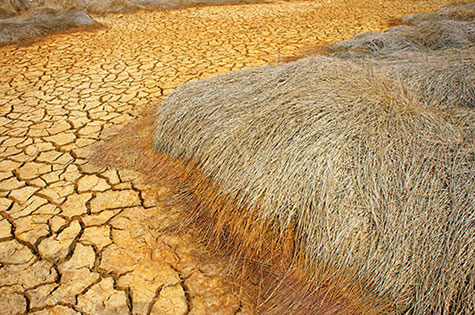The Dirty Thirties’ Second Coming?
By: Sylvain Charlebois
Most experts believe major fires at Fort Mc Murray suggest we should become accustomed to major disasters that may be linked to the long-term effects of climate change. Climate change is affecting anything and everything, but stakes are different in the Prairies. In fact, according to a recent study from Manitoba, the Prairie region represents a unique case around the world. The study points to a real challenge asserting that the Canadian Prairie region could be the most affected area in the world over the next few decades. Jeopardizing our breadbasket makes climate change the most serious threat to our food security.
 Learning that climate change will affect agriculture is not overly surprising, but the expected pace is jaw-dropping. The Manitoba-based report suggests that summers in the Prairies will become hotter and longer. Using a Prairie Climate Atlas, a group of scientists predicted that over the next 50 to 60 years the climate picture is not pretty. For example, the atlas predicts Winnipeg could see 46 days a year of temperatures over 30 degrees C., a temperature which is four times what the city experiences now. Currently, Winnipeg experiences 11 days of 30 degree weather on average a year. For Edmonton, Calgary, Regina and Saskatoon the number could grow up to seven times current averages. These are desert-like temperatures, similar to what one finds in Texas, or even in Mexico. And yes, fire-stricken Fort McMurray is likely to experience warmer and dryer weather in the future.
Learning that climate change will affect agriculture is not overly surprising, but the expected pace is jaw-dropping. The Manitoba-based report suggests that summers in the Prairies will become hotter and longer. Using a Prairie Climate Atlas, a group of scientists predicted that over the next 50 to 60 years the climate picture is not pretty. For example, the atlas predicts Winnipeg could see 46 days a year of temperatures over 30 degrees C., a temperature which is four times what the city experiences now. Currently, Winnipeg experiences 11 days of 30 degree weather on average a year. For Edmonton, Calgary, Regina and Saskatoon the number could grow up to seven times current averages. These are desert-like temperatures, similar to what one finds in Texas, or even in Mexico. And yes, fire-stricken Fort McMurray is likely to experience warmer and dryer weather in the future.
These are staggering statistics. More heat and less moisture will compromise our ability to grow our agrifood economy. But also, other than farmers, reports on climate change suggest that the most vulnerable to climate change include people and families with less means and Aboriginal communities. Food will likely become less affordable and the ability for some remote regions to grow food will be negatively affected.
Globally, Canada is currently ranked seventh in the world in cereal production and 9th in the world in meat production. Canada is 1st in rapeseed, 2nd in oats, 3rd in pulses, 4th in barley and, as an agricultural exporting country, Canada is 6th in the world. The Prairies are home to nearly half of Canada’s farms and much larger shares of its cropland and grassland bases. Reports claim that crop yields could easily drop by more than 50% in the Prairies due to climate change. Consequently, our contribution to global food systems could seriously be endangered. Changes in weather cycles can also influence crop pests and disease as they could increase due to higher levels of atmospheric carbon dioxide. Increased prevalence of pests and pathogens in livestock and crops is also a definite possibility in the future. With many more days of 30 degree temperature the severity and impact can potentially be significant as well.
Water irrigation issues have been on the radar for quite some time in the Prairies, but climatic perils may be too much for what is currently being done. What will affect the Prairie region is not only for the Prairies to deal with, but is a matter for all Canadians.
Media coverage of droughts in California and other regions have been extensive. But we rarely consider how weather patterns can affect our own agrifood sector here in Canada. Adaptation will be part of the new normal in addressing water scarcity and changes in temperature. Coping with the impacts of climate change will involve a comprehensive plan which allows for policymakers and industry stakeholders alike to identify and develop prevention measures to offset what is likely to happen. Most importantly, what goes on in urban areas affects rural Canada, and this most recent survey calls for changes that not only safeguard our quality of life in cities, but also for the future of food systems in general. Ontario’s climate change plan is a good start, but it will require a multi-sectorial, multi-regional strategy which needs to be captured in our national food strategy.
Ottawa still has yet to generate or endorse a powerful and influential food national strategy for Canadians. Compared to America’s Farm Bill, Canada’s Growing Forward is mainly an inconsequential attempt to check all the proverbial political boxes. The depression and drought of the Dirty Thirties were shattering. This time we have data to prevent this from happening again and a clear vision for our agrifood systems that can make a difference for the sake of all Canadians and the world.
About the Author
Dr. Sylvain Charlebois is Dean of Management and Professor in Food Distribution and Policy for Dalhousie University’s Faculty of Management and Faculty of Agriculture. He has authored nearly 200 publications in peer-reviewed journals, leading news publications, professional publications and conference proceedings in food science and management . He has an expertise in global food safety, traceability systems and risk intelligence and he is a member of both the Global Food Traceability Centre Advisory Board and the National Canadian Food Inspection Agency.

Categories: Food Safety Challenges, Risk Management
Tags: climate change , national food strategy , Sylvain Charlebois



